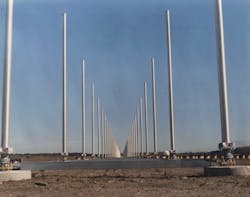Navy asks Raytheon to upgrade software on long-range radar that bounces HF radio waves off the ionosphere
PHILADELPHIA – Long-range radar experts at Raytheon Technologies Corp. will upgrade and maintain software for a U.S. Navy surveillance system designed to detect and track aircraft and surface ships all over the Caribbean from the Florida Coast to South America.
Officials of the Naval Supply Systems Command Fleet Logistics Center, Norfolk, Contracting Department, Philadelphia Office in Philadelphia announced a four-year $87.5 million contract Monday to the Raytheon Intelligence & Space segment in Woburn, Mass., to upgrade the Relocatable Over-The-Horizon Radar (ROTHR) at the Forces Surveillance Support Center in Chesapeake, Va.
The ROTHR over-the-horizon radar uses high-frequency (HF) radar waves that bounce off a layer of the atmosphere called the ionosphere to provide long-range over-the-horizon radar coverage. It achieves long ranges by skipping waves off the ionosphere, just like shortwave radio.
ROTHR uses HF radio waves, which are particularly susceptible to interference from lightning almost anywhere in the world. HF signal reception also changes throughout the course of the day and the seasons, as well as at night, so ROTHR poses a particularly difficult digital signal processing (DSP) problem.
ROTHR is designed to provide early warning of strikes against aircraft carrier task forces, and is suited especially for long-range surveillance of large open-water areas out to ranges as far as 2,500 nautical miles.
The U.S. Navy operates two ROTHR systems, one in Chesapeake, Va., and the other in Corpus Christi, Texas. Together, these radar systems cover most of the Caribbean, and extend into the Pacific coat of Central America and South America as far south as the Galapagos Islands.
As their name implies, the ROTHR systems can be moved, and have been redeployed for detection and monitoring of air traffic in the U.S. government's war against drugs, Raytheon officials say.
The ROTHR system has been operational with the U.S. government for more than 25 years, supporting the counter drug mission in the Caribbean and South America, and early warning detection for Navy vessels at sea.
ROTHR originally was developed to keep long-range watch for cruise missiles and other low-flying threats to the U.S. mainland well offshore. Eventually ROTHR took over monitoring drug smuggling in the Caribbean.
The radar provides more than 2.5 million square miles of coverage and detects more than 350,000 targets per year. It is currently the U.S. government's primary surveillance system for the counter-drug mission, Raytheon officials say.
Raytheon has been upgrading the radars since the initial installations to improve performance and reliability. Performance improvements included state of the art computers and displays and enhanced software for more accurate tracking of small aircraft and boats.
On this contract Raytheon will do the work in Chesapeake, New Kent, and Arlington, Va.; Marlboro, Mass.; Corpus Christi, Texas; San Juan, Puerto Rico; Adelaide, Australia; Dayton, Ohio; Colorado Springs, Colo.; Washington, D.C.; and Key West, Fla., and should be finished by August 2027.
For more information contact Raytheon Intelligence & Space online at www.raytheonintelligenceandspace.com, or the Naval Supply Systems Command Fleet Logistics Center at www.navsup.navy.mil.
About the Author
John Keller
Editor-in-Chief
John Keller is the Editor-in-Chief, Military & Aerospace Electronics Magazine--provides extensive coverage and analysis of enabling electronics and optoelectronic technologies in military, space and commercial aviation applications. John has been a member of the Military & Aerospace Electronics staff since 1989 and chief editor since 1995.
